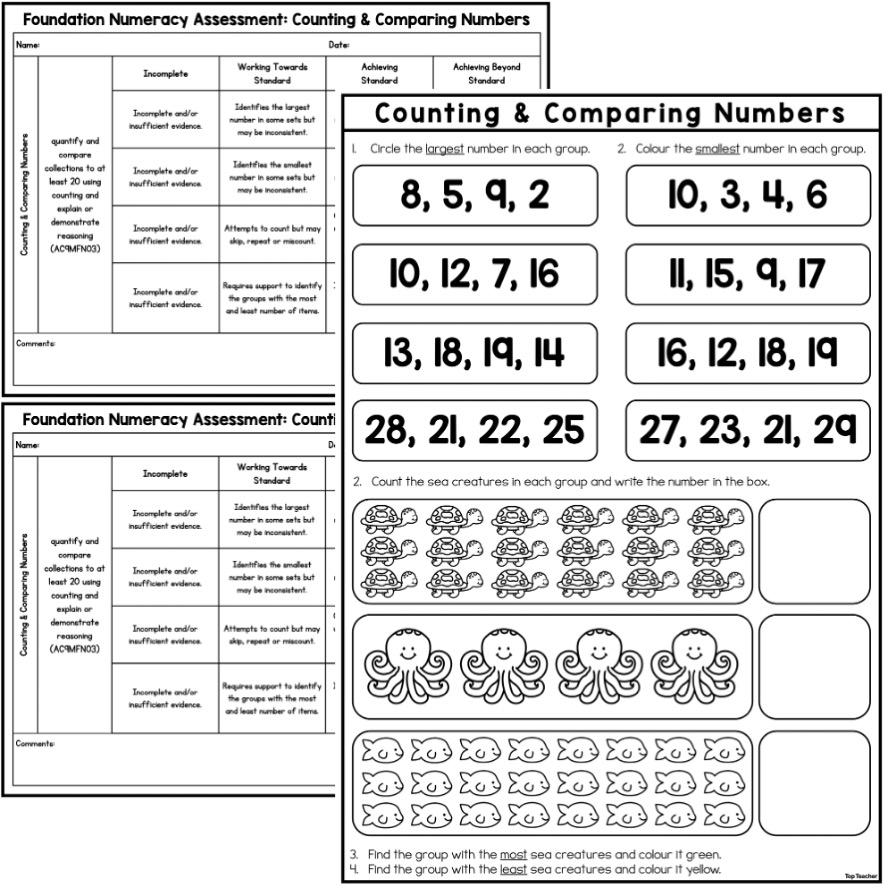Counting & Comparing Numbers Numeracy Assessment: Foundation

Description
Counting & Comparing Numbers Numeracy Assessment: Foundation supports your students in developing early number sense through structured and purposeful assessment tasks. This versatile resource is designed to assess students’ ability to count, identify and compare numbers and quantities up to at least 20 while using mathematical language to explain their reasoning.
This resource is ideal for both formative and summative assessment and can be used during whole-class teaching, small group instruction or intervention settings. It is also a strong addition to student portfolios and goal-setting activities. The included Australian Curriculum-aligned rubric is detailed and editable, allowing you to adapt it to suit your school’s assessment focus or student learning goals. An answer sheet is provided to make marking efficient and time-saving.
Counting & Comparing Numbers Numeracy Assessment: Foundation includes engaging tasks that help identify whether students can confidently count collections, recognise quantities, and compare numbers using appropriate vocabulary. Each activity encourages students to apply their number knowledge while explaining their thinking, helping to build strong mathematical communication skills from the start of their schooling journey.
Across the three assessment components, students will practise key numeracy skills. First, they identify the greatest or smallest number from a given set of numerals. Next, they count collections of sea animals and record their answers. Finally, they compare two groups and determine which has more or fewer items. These progressive steps ensure that students are engaging with a range of number comparison and counting tasks, providing a well-rounded snapshot of their understanding.
Key Learning Outcomes:
- ✅ Identify and count collections of objects up to at least 20
- ✅ Recognise, compare and order numerals
- ✅ Use comparative language such as ‘more’, ‘less’, ‘greater’ and ‘smaller’
- ✅ Develop reasoning and explanation skills when comparing quantities
- ✅ Record and represent number understanding clearly
What’s Included:
- Student assessment worksheet set
- Editable Australian Curriculum-aligned teacher rubric
- Answer sheet for quick and consistent marking
Materials Needed:
- Printed assessment worksheets
- Pencils or markers
- Counting manipulatives (optional)
- Number line or reference chart (optional support)
How to Use:
- Introduce comparison vocabulary (more, less, greatest, smallest) through real-life examples or classroom items.
- Provide students with the worksheet and review the three sections together.
- Guide students to circle the largest or smallest numeral from a given group.
- Have them count each group of sea animals and record the total in the box provided.
- Support students in comparing the totals and identifying which group has more or fewer animals.
- Encourage verbal or written explanations to build number reasoning and vocabulary.
Ideas for Classroom Use:
- 💡 Use at the beginning or end of a number unit as a pre- or post-assessment
- 💡 Implement in small groups for focused teacher observation
- 💡 Add completed assessments to student portfolios as evidence of achievement
- 💡 Use as a conversation starter during parent-teacher interviews or goal-setting meetings
- 💡 Create display examples showcasing how students explain their thinking
Top Teacher Tips:
- 💛 Encourage students to count out loud to help identify counting errors and support one-to-one correspondence
- 💛 Offer number lines or counters for students needing additional support
- 💛 Reinforce consistent use of comparative language throughout your maths block
- 💛 Create & Compare: Ask students to draw two or more collections and challenge a classmate to compare them
- 💛 Beyond 20: Extend confident students by using larger numbers or asking them to write a sentence explaining their choice
- 💛 Revisit the same task later in the term to observe growth in counting fluency and comparison vocabulary
Counting & Comparing Numbers Numeracy Assessment: Foundation provides a clear, structured and meaningful way to assess students’ ability to identify, count and compare numbers. It’s a must-have tool for supporting curriculum-aligned assessment and informing next steps in number instruction.
Additional information
| Number of Pages | 3 |
|---|---|
| File Format | zip |
| Australian Curriculum Code | AC9MFN01 |
Australian Curriculum V9
F - 6
Lorem ipsum dolor sit amet, consectetur adipiscing elit.
Lorem ipsum dolor sit amet, consectetur adipiscing elit.
Lorem ipsum/ Lorem ipsum/ Lorem ipsum
Lorem ipsum dolor sit amet, consectetur adipiscing elit.
Lorem ipsum dolor sit amet, consectetur adipiscing elit.
Lorem ipsum/ Lorem ipsum/ Lorem ipsum
Lorem ipsum dolor sit amet, consectetur adipiscing elit.
Lorem ipsum dolor sit amet, consectetur adipiscing elit.
Lorem ipsum/ Lorem ipsum/ Lorem ipsum
Lorem ipsum dolor sit amet, consectetur adipiscing elit.
Lorem ipsum dolor sit amet, consectetur adipiscing elit.
Lorem ipsum/ Lorem ipsum/ Lorem ipsum
Lorem ipsum dolor sit amet, consectetur adipiscing elit.
Lorem ipsum dolor sit amet, consectetur adipiscing elit.
Lorem ipsum/ Lorem ipsum/ Lorem ipsum

